Acanthurus bahianus
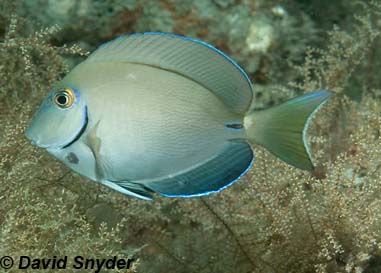
This oval-shaped tropical reef fish is a popular aquarium and bait fish. It is sometimes offered as a fresh catch locally, but handle with care if catching because of the sharp spine hidden in the caudal peduncle (narrow area just before the tail).
These vegetarians play an important role on the reefs by eating the algae that can grow over the coral and kill it.
Order – Perciformes
Family – Acanthuridae
Genus – Acanthurus
Species – bahianus
Common Names
English language common names are ocean surgeon, barber, doctorfish, grey doctorfish, ocean surgeonfish, ocean tang, ringtail, and shitty trooper. Other common names include barbeiro (Portuguese), barber (Spanish), chirurgien marron (French), cirujano (Spanish), cirujano pardo (Spanish), medico (Spanish), navajero (Spanish), navajón (Spanish), navajón pardo (Spanish), peixe-cirurgião (Portuguese), sangrador (Spanish), sangrador lucio (Spanish), siwizye (Creole/French), and vestatlantisk kirurgfisk (Danish).
Importance to Humans
The ocean surgeon is only of minor interest to commercial fisheries, however it is important in subsistence fisheries where it is caught in traps and gill nets and by spear fishing. Care must be taken when handling this species due to the spines located on the sides of the caudal peduncle which may inflict painful wounds. The flesh is locally marketed as fresh. This species along with other member of this family are small in size and display interesting coloration, making popular fish in public aquariums.
Conservation
> Check the status of the ocean surgeon at the IUCN website.
The IUCN is a global union of states, governmental agencies, and non-governmental organizations in a partnership that assesses the conservation status of species. The global trend of coral reef destruction could result in future endangerment.
Geographical Distribution
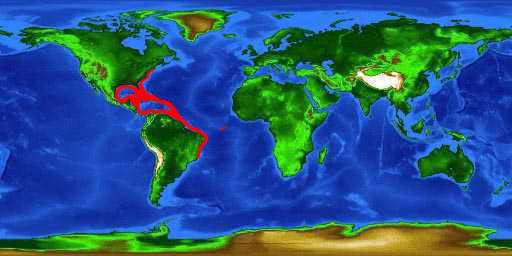
The member of the Acanthuridae resides in the western Atlantic Ocean from Massachusetts (US) and Bermuda, south to the Gulf of Mexico (except the northeastern region where it is apparently replaced by Acanthurus randalli), and Brazil. In the eastern Atlantic basin, it is found off Ascension and St. Helena Islands off Angola. Although there has been a recent reporting of the ocean surgeon from Seychelles, it is believe to be in error.
Habitat
Inhabiting shallow bottoms over coral and rock formations, the ocean surgeon typically occurs in groups of five or more. It is primarily a diurnal species and often schools with other species including the blue tang and surgeonfish.
Biology
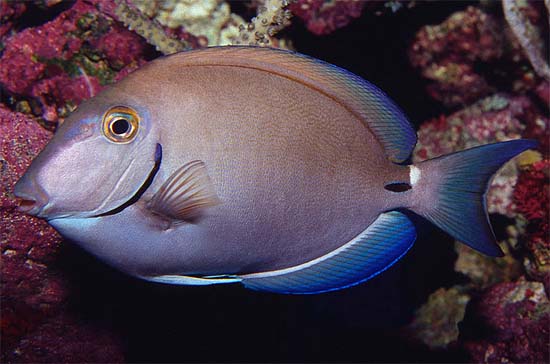
Distinctive Features
The oval-shaped body of the ocean surgeon is moderately deep and compressed. The mouth is small and low on the head, well adapted for scraping algae from rocks and coral. There is a sharp scalpel-like spine located on the side of the caudal peduncle that fits into a horizontal groove. The relatively long dorsal fin is continuous and unnotched. The caudal fin is moderately to deeply emarginated. The scales are small and ctenoid. The stomach is gizzard-like (see food habit section for more information).
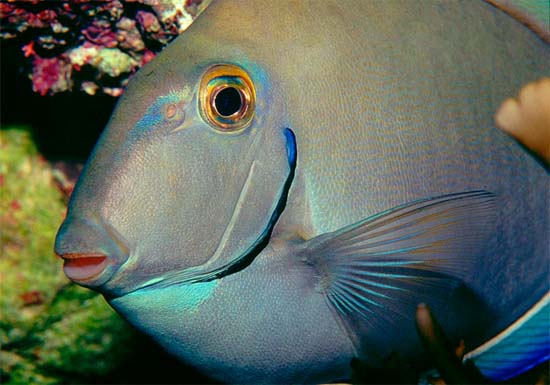
Coloration
The ocean surgeon is yellowish to grayish brown with pale greenish gray to pale blue vertical lines on the body. There are short yellow lines radiating from the posterior margin of the eye within a narrow blue area. The dorsal fin has a blue margin and alternating bands of orange and bluish green. The anal fin is similarly colored but with fewer less obvious bands.
The caudal fin is olive to brown changing abruptly to white or paler at the base with a bluish white posterior margin. There is a small violet or blue region at the socket of the caudal spine. Color changes may occur during spawning as well as intraspecific competition and other communication
Dentition
Dentition of the ocean surgeon is especially adapted for feeding on filamentous species of benthic algae. It has close-set denticulate edged spatulate teeth in the small mouth. There were reported to be 14 teeth in the upper jaw and 16 teeth in the lower jaw of a specimen measuring 6.7 inches (17cm) standard length.
Size, Age, and Growth
The blue tang reaches approximately 12 inches (30.5 cm) in length. The largest specimen, caught off the coast of South America, measured 14.4 inches (37 cm). It reaches sexual maturity at 9-12 months of age and lengths of 4-5 inches (11-13 cm).
Food Habits
Acanthurids are diurnal fishes, feeding primarily on green and brown algae along with a small amount of small invertebrates. Their small mouths and specialized teeth pick up large quantities of coral and sand while feeding on algal mats along the bottom substrate. The ocean surgeon has thin-walled intestines filled with sand and various flora and fauna thought to aid in the digestion of its algal diet. In particular, this species feeds on algae including species of the genera of Dictyota, Cladophora, Chaetomorpha, Ceramium, and Thalassia.
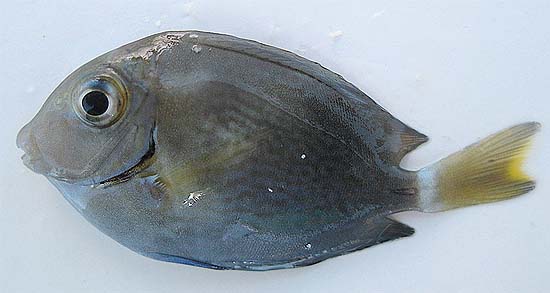
Reproduction
Spawning occurs from November to April with the peak season from December to March. Members of the genus Acanthurus spawn by forming pairs or more commonly in aggregations of pairs. Color changes may occur during spawning as well as intraspecific competition and other forms of communication.
The pelagic eggs are spherical with a single oil globule. Each measures 0.17mm in diameter. Upon hatching, the larvae are kite-shaped with an elongate snout and a small terminal mouth. Falling prey to larger fish and other marine animals, larvae are often found in the stomachs of tuna. Transformation to the juvenile stage occurs at approximately 23-33m in length corresponding to following a 42-68 day pelagic larval phase. As the larvae settle out of the water column and develop into juveniles, they seek the protection and resources of reef and seagrass habitats.
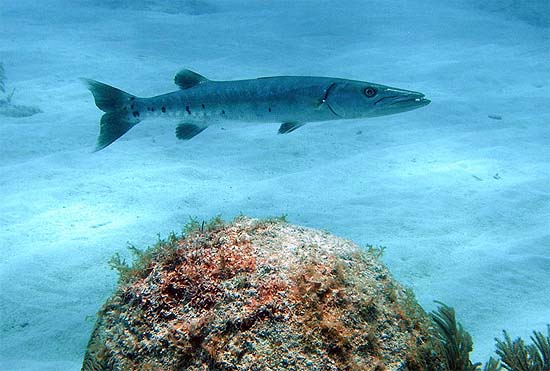
Predators
Larger fish are potential predators of the ocean surgeon. Documented predators of this reef fish include mutton snapper (Lutjanus analis), tiger grouper (Mycteroperca tigris), yellowfin grouper (Mycteroperca venenosa), trumpetfish (Aulostomus maculatus), and the great barracuda (Sphyraena barracuda). The scalpel-like spine located on each side of the caudal peduncle is used as the primarily defense mechanism against predators. These spines are used in a slashing motion to inflict serious wounds on the unfortunate victim. Predation pressures are highest on this species during the larval life stage in the open ocean.
Parasites
Parasites reported from the ocean surgeon include the isopods Anilocra acanthuri and Gnathia puertoricensis as well as the digenic trematode Macradena acanthuri from the stomach of a specimen. The ocean surgeon is frequently cleaned by juvenile French angelfish (Pomacanthus paru).
Taxonomy
The ocean surgeon was originally described as Acanthurus bahianus (Castelnau 1855) from a specimen collected off Brazil. This name currently remains the valid scientific name for this species. Synonyms referring to this species in past scientific literature include Hepatus bahianus Castelnau 1855, Teuthis bahianus Castelnau 1855, Acanthurus tractus Poey 1860, Teuthis tractus Poey 1860, and Acronurus nigriculus Poey 1875. The genus name Acanthurus is derived from the Greek “acantha” which means thorn, and the Greek “oura” which means tail. The ocean surgeon is one of 75 species in the surgeonfish family, Acanthuridae. This family of fishes is referred to as surgeonfish due to the very sharp, movable spines on either side of the tail that resemble surgeons’ scalpels.
Recently, there has been some debate about this species and its distribution. The ocean surgeon has been recorded from Bermuda to Massachusetts to southern Brazil and islands in the central Atlantic. However individuals from the southwestern and central Atlantic region have a bright yellow posterior yellow margin on the caudal fin and an orange to red margin on the dorsal fin which is in contrast to the white/blue fin margins on specimens from the northwestern Atlantic. It has been suggested that this is a separate species and biologists have proposed a resurrection of the species Acanthurus tractus (Poey 1860) as the valid name for this northwestern species while the south Atlantic species retains the name Acanthurus bahianus.
Prepared by: Cathleen Bester